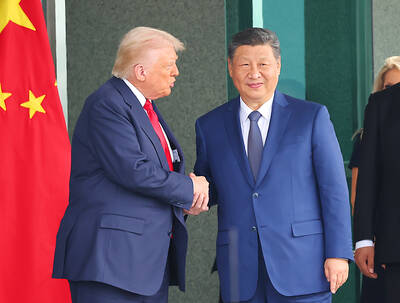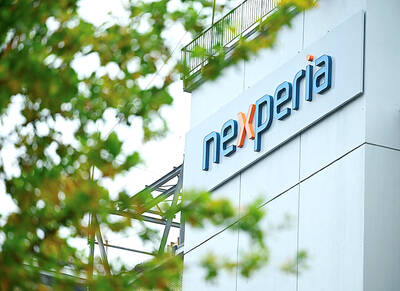Acer Inc (宏碁), the world’s fourth-largest PC vendor, yesterday reported its second quarterly net loss in a row, but said its operating loss in the third quarter had greatly improved from the second quarter.
In the three months that ended on Sept. 30, the company’s net loss was NT$1.1 billion (US$36 million), or a loss of NT$0.43 per share, Acer said in an e-mailed statement.
The figure represented a significant improvement from a net loss of NT$6.79 billion, or a loss of NT$2.57 per share, in the second quarter. On an annual basis, however, that compares with a net income of NT$4.29 billion, or earnings per share of NT$1.61, in the third quarter last year, company data showed.
Over the past two quarters, Acer has been working to adjust its inventories and fine-tune its business strategy in the face of declines in netbook and notebook sales because of the impact of tablet devices, such as the iPad.
The company is also undergoing restructuring pains following the departure of a number of key executives, such as former chief executive Gianfranco Lanci, former global marketing vice president Gianpiero Morbello and the former president of its handheld intelligence group, Aymar de Lencquesaing.
On a positive note, the company’s consolidated revenue increased 14.9 percent quarter-on-quarter to NT$117.3 billion in the third quarter, although the figure was still nearly 30 percent lower than a year earlier.
“Acer’s third-quarter consolidated revenue grew from the second quarter, with channel inventories significantly reduced to a reasonable level,” the statement said.
Operating loss in the third quarter also dropped 81.4 percent to NT$1.32 billion from NT$7.09 billion in the second quarter, after the company wrote off US$150 million of inventories in Europe and on its account receivables in Spain in the second quarter, as well as earmarking another US$30 million for layoff-related expenses.
“Comparing the two quarters’ operating losses on the same bases, by deducting the one-time sales allowance and senior executive severance fees that took place in the second quarter, the margin of the third-quarter operating loss has improved from the second quarter,” Acer said in the statement.
In the first three quarters of the year, Acer’s consolidated revenue totaled NT$347.2 billion, down 27.7 percent from a year ago. The company said operating losses amounted to NT$6.48 billion in the first three quarters, while net losses were NT$6.71 billion, or a loss of NT$2.55 per share.
The company did not provide a sales guidance or an earnings outlook for the current quarter.
Acer chairman and chief executive J.T. Wang (王振堂), who said in August that the company might not be able to break even this year, may shed some light on the progress of the company's restructuring and any impact from potential supply-chain disruption because of the floods in Thailand on Friday next week during its quarterly conference with investors and analysts.
Acer shares fell 1.24 percent to close at NT$35.80 before the announcement of the third-quarter results. The stock has plunged 60.27 percent since the beginning of the year, compared with the benchmark index’s decline of 19.15 percent during the same period.

TEMPORARY TRUCE: China has made concessions to ease rare earth trade controls, among others, while Washington holds fire on a 100% tariff on all Chinese goods China is effectively suspending implementation of additional export controls on rare earth metals and terminating investigations targeting US companies in the semiconductor supply chain, the White House announced. The White House on Saturday issued a fact sheet outlining some details of the trade pact agreed to earlier in the week by US President Donald Trump and Chinese President Xi Jinping (習近平) that aimed to ease tensions between the world’s two largest economies. Under the deal, China is to issue general licenses valid for exports of rare earths, gallium, germanium, antimony and graphite “for the benefit of US end users and their suppliers

Dutch chipmaker Nexperia BV’s China unit yesterday said that it had established sufficient inventories of finished goods and works-in-progress, and that its supply chain remained secure and stable after its parent halted wafer supplies. The Dutch company suspended supplies of wafers to its Chinese assembly plant a week ago, calling it “a direct consequence of the local management’s recent failure to comply with the agreed contractual payment terms,” Reuters reported on Friday last week. Its China unit called Nexperia’s suspension “unilateral” and “extremely irresponsible,” adding that the Dutch parent’s claim about contractual payment was “misleading and highly deceptive,” according to a statement

The Chinese government has issued guidance requiring new data center projects that have received any state funds to only use domestically made artificial intelligence (AI) chips, two sources familiar with the matter told Reuters. In recent weeks, Chinese regulatory authorities have ordered such data centers that are less than 30 percent complete to remove all installed foreign chips, or cancel plans to purchase them, while projects in a more advanced stage would be decided on a case-by-case basis, the sources said. The move could represent one of China’s most aggressive steps yet to eliminate foreign technology from its critical infrastructure amid a

Nissan Motor Co has agreed to sell its global headquarters in Yokohama for ¥97 billion (US$630 million) to a group sponsored by Taiwanese autoparts maker Minth Group (敏實集團), as the struggling automaker seeks to shore up its financial position. The acquisition is led by a special purchase company managed by KJR Management Ltd, a Japanese real-estate unit of private equity giant KKR & Co, people familiar with the matter said. KJR said it would act as asset manager together with Mizuho Real Estate Management Co. Nissan is undergoing a broad cost-cutting campaign by eliminating jobs and shuttering plants as it grapples